What is Edema?
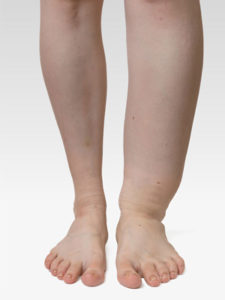
The title edema comes from the Greek word ‘oidein,’ which means ‘to swell.’ It was first used as a medical term in the 14th century and is now known as edema. Edema today is a medical term usually referred to as the swelling of edematous subcutaneous tissue due to the accumulation of body fluids.
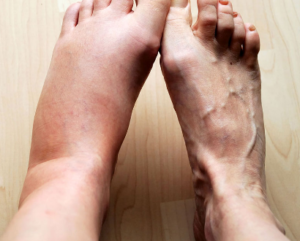
Edema or fluid retention can happen at any part of the body; it can be, for instance, pulmonary or macular, as well. But it is more common in hands, arms, feet, ankles, and legs. Usually, this condition begins at a slow pace. It gradually develops to a stage where it can cause pain, soreness, heaviness, and difficulty in movement.
When body fluids start responding to gravitational pull and start pooling in the lower extremities or upper limbs of the body, then the condition is called dependent edema.
Want to Stop Leg Swelling and Improve Athletic Performance?
ComproGear Compression Socks are designed to stop swelling instantly!
Click the button below to see the lineup of ComproGear Compression Socks:
Shift workers and professionals like pilots, athletes, and retailers also have a high risk of dependent edema, swollen feet, and ankles. Although the condition itself is not fatal or highly dangerous to the health of the person, it can cause extreme discomfort, soreness, pain, and difficulty in movement. Sometimes swollen feet and ankles can also be a symptom of some other underlying disease like cardiovascular disease, DVT, and other venous disorders.
Let’s talk compression stockings edema solutions…

Classification and Types
There are numerous types of edema, but the most common of them all is the one that affects your feet and legs. This article will discuss in detail the edema of the feet. Still, it’s types are classified based on specific organs they influence.

But to give you an idea here is a list of some other types of edema:

- Pedal or dependent (edema of feet and legs)
- Pulmonary
- Hereditary
- Cerebral
- Lymphedema
- Myxedema
- Macular
Common Symptoms

If you are affected by edema, you will probably experience one or more of the following symptoms:
- Soreness, puffiness, and heaviness of feet
- Tightening and pitting on the skin surface (in case of pitting edema)
- Swelling of fingers, toes, ankles, and legs
- Pain in limbs, difficulty in moving and changing footwear
- Lethargy, stiffness, and headaches
- Increased ankle and feet measurement
Causes

Some of the most common causes people to suffer include:
- Sitting or standing for too long (during traveling or working)
- Physical inactivity for any other reason like bed rest
- Cardiovascular disease
- Kidney damage or disease (the limited ability of the kidney to extract sodium from blood)
- Lymphedema
- Cirrhosis (usually of the liver)
- Trauma or injury to legs, feet or ankles
- Side effects of certain medications
- Increased salt intake
- DVT (Deep Vein Thrombosis)
- Wakened veins or chronic venous disease
- Low levels of albumin (Loss of protein in the urine)
- Sunburn
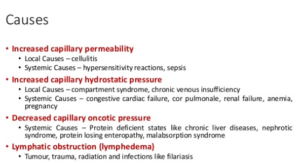
A few times, the condition is so severe that the accumulated fluid starts to seep from the skin surface in the form of a yellowish liquid. This is blood plasma or the water content in our blood.
Pitting edema can be diagnosed with a simple finger test by applying pressure on the swollen area with a finger and see if depression or pit has appeared in that area due to the displacement of the underlying fluids.
Want to Stop Leg Swelling and Improve Athletic Performance?
ComproGear Compression Socks are designed to stop swelling instantly!
Click the button below to see the lineup of ComproGear Compression Socks:
Popular Articles on ComproGear
Best Compression Socks for Ankle Swelling Best for Swollen Feet
Compression Sock Sizes What Size Compression Socks Do I Need?
Best Compression Socks for Nurses Review of the Best Socks for Nursing
Plus Size Compression Socks Largest Compression Socks in 2XL, 3XL, 4XL, 5XL, and 6XL
Graduated Compression Leggings Review of the Best Tights and Leggings
Best Compression Socks for Standing All Day Are Compression Socks Good for Standing All Day?

Treatments and Therapies of Edema and Swollen Feet

Compression Therapy
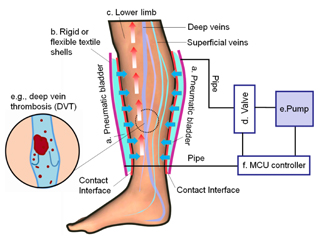
One of the most effective remedies available for edema patients today is compression therapy. Compression therapy is a technique by which patients can use compression hosiery to reduce the symptoms of the disease. Compression hosiery includes compression socks and sleeves. These garments apply gradual pressure to your limbs and prevent blood accumulation in your ankles and feet.
Oral Drugs

The most common drugs used for the treatment of edema include corticosteroids, diuretics, and carbonic anhydrase inhibitors. Edema can also be treated by actually stopping some of the medication that is the cause of such conditions. Anti-inflammatory drugs, steroids, blood pressure, and some diabetes medicine can bet the cause of edema. Your physician may reduce particular medication after the real culprit of the disease is diagnosed.
Elevation of Lower Body
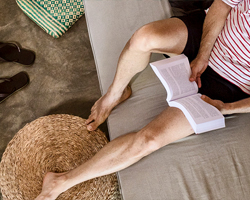
Elevating the lower body is a temporary way to reduce puffiness and swelling of the feet by draining the accumulative fluids in the feet towards the core of the body. The blood leaves the lower limbs gradually (aided with gravity), and there is a reasonable relief in soreness and pain.
Exercise
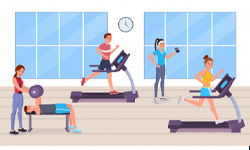
Aerobic exercises, walking, and stretching keeps your body in shape, and you maintain your general wellness. Exercising can especially help with edema patients by improving blood circulation through muscles and blood vessels of the limbs. You can choose simple regular exercises to maintain their health and avoid swollen feet and ankles.
Increasing Magnesium in the Diet

Magnesium deficiency is another cause of swollen feet and ankles. You can use magnesium supplements as well as natural foods with magnesium to keep your magnesium levels enough to reduce any edema symptoms. You can also ask your physician or doctor for supplements that are more suitable for your particular symptoms and nursing routine.
Soaking your feet in Epsom salt

After a long nursing shift, an easy solution to get rid of your swollen feet and ankles is soaking them in Epsom salt (in warm water). Epsom salt has high concentrations of magnesium sulfate and improves blood circulation in your feet naturally. You can use this remedy with both warm and cold water according to your preference.
Want to Stop Leg Swelling and Improve Athletic Performance?
ComproGear Compression Socks are designed to stop swelling instantly!
Click the button below to see the lineup of ComproGear Compression Socks:
When Should You Seek Help?

If you have assessed yourself that you have edema symptoms, you should consult your physician right away without any further delay. Swollen legs may not pose an immediate and severe threat to your health; however, they may be a symptom of a dangerous underlying disease.

You must seek medical advice as soon as possible in case you experience edema along with:
- You are pregnant
- Headaches, migraine, loss of consciousness
- Pain in the chest or abdomen and difficulty in breathing or heavy breathing
Compression Stockings for Edema Care and Swollen Feet

Compression socks and sleeves are clinically proven to be highly effective in reducing swollen feet and treating edema. Physicians recommend them for moderate swelling as well as chronic edema patients.
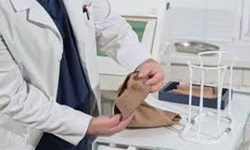
Manufacturers use elastic material to make these compression stockings. This enables the garment to apply a continuous and calculated amount of pressure to your feet, ankles, and legs. That is why these are sometimes also known as pressure socks.
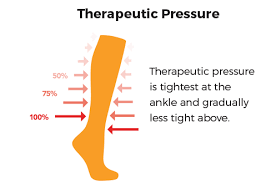
This pressure simply squeezes your feet gently and narrows the veins on the surface, increasing the flow of blood through them. The blood rushes out of the feet and ankles quickly and goes back to the core of the body. This makes the individual feel better and relieve the swelling as well.
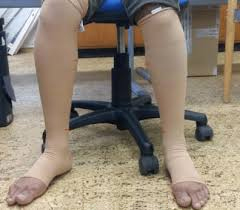
Most of the compression stockings are purchasable without a doctor’s prescription, so you can order them online or buy them from a store.
Another essential aspect of compression hosiery and its effectiveness is the correct size. Remember, the principle of compression stockings is mechanical pressure built on your limbs through elastic fabric wrapped around your feet. The right application of this continuous pressure is essential for the socks to work correctly. So when choosing the socks, measure your size and buy the correct size for your feet.
How Long Should One Wear Compression Socks
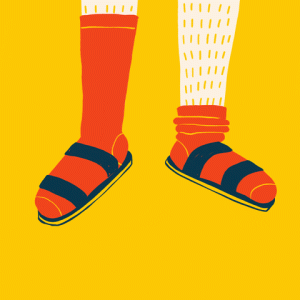
Your doctor can guide you on how and when to wear your compression socks. However, most of the edema patients wear them first thing in the morning as swelling is generally less in the morning, and it’s easier to slide the socks up.

If your condition is due to the nature of your day job and daily routine, then you should wear them at work and for day to day activities.

If you are using oral medications or some other treatments, then you can reduce your wear time. Also, compression socks are usually not worn during the night. So avoid wearing them when you go to bed.
You may have to use compression stockings for a long duration, maybe for the rest of your life to keep your edema under control. Some patients can experience such severe damage that their venous system gets weak permanently. So, if they ever stop using them, it can be dangerous for them.

Caring For Your Socks
You can wear socks with your footwear and even regular socks as well. You should also have spare pairs of socks in case you want to wash a couple. You must keep your toenails clipped to avoid any cuts or damage to the socks.

If you buy good quality socks, they are likely to last long and will not loosen up from daily use. However, if they do, you will have to change them. You should wash your socks with care and at room temperature to avoid any damage to the fabric.
When you wear your socks, make sure that there are no folds, kinks, or bunched up fabric at either end of the stockings. Otherwise, the hose can leave indentation and may stop blood flow instead then improving it.

Best Compression Level:

There are different categories of socks according to the pressure they apply on the leg, usually measured in mm Hg. Mm, Hg is a unit of force and stands for millimeters of mercury. You must choose the compression according to your stage of edema and symptoms. Here are some guidelines:
Light Compression: Light compression stockings usually apply 10 – 15 mm individuals generally use Hg of pressure to your legs and with a minor (or not so frequent) swelling problems.
Moderate or Medium Compression: An average or medium compression usually applies a compression of 20 – 30 mm Hg on your limbs. This type is ideal for individuals suffering from chronic edema, swelling, pain relief, soreness, varicose veins, post-surgery recovery, and pregnant mothers.
High Compression Hosiery: High compression socks usually apply compression of about 30 – 40 mm Hg. You should not use this range unless you get a recommendation from your physician for certain conditions like DVT and acute cases of lymphedema.
Final Word

Here’s what to do now; if you are experiencing symptoms of edema, you can schedule an appointment with your physician. The second thing you need to do is to buy a pair of compression socks online or from your nearest drug store and give it a try. You can also ask your doctor about the type and compression level of the stockings as well. Choose your favorite color and preferred style today.
Want to Stop Leg Swelling and Improve Athletic Performance?
ComproGear Compression Socks are designed to stop swelling instantly!
Click the button below to see the lineup of ComproGear Compression Socks:
